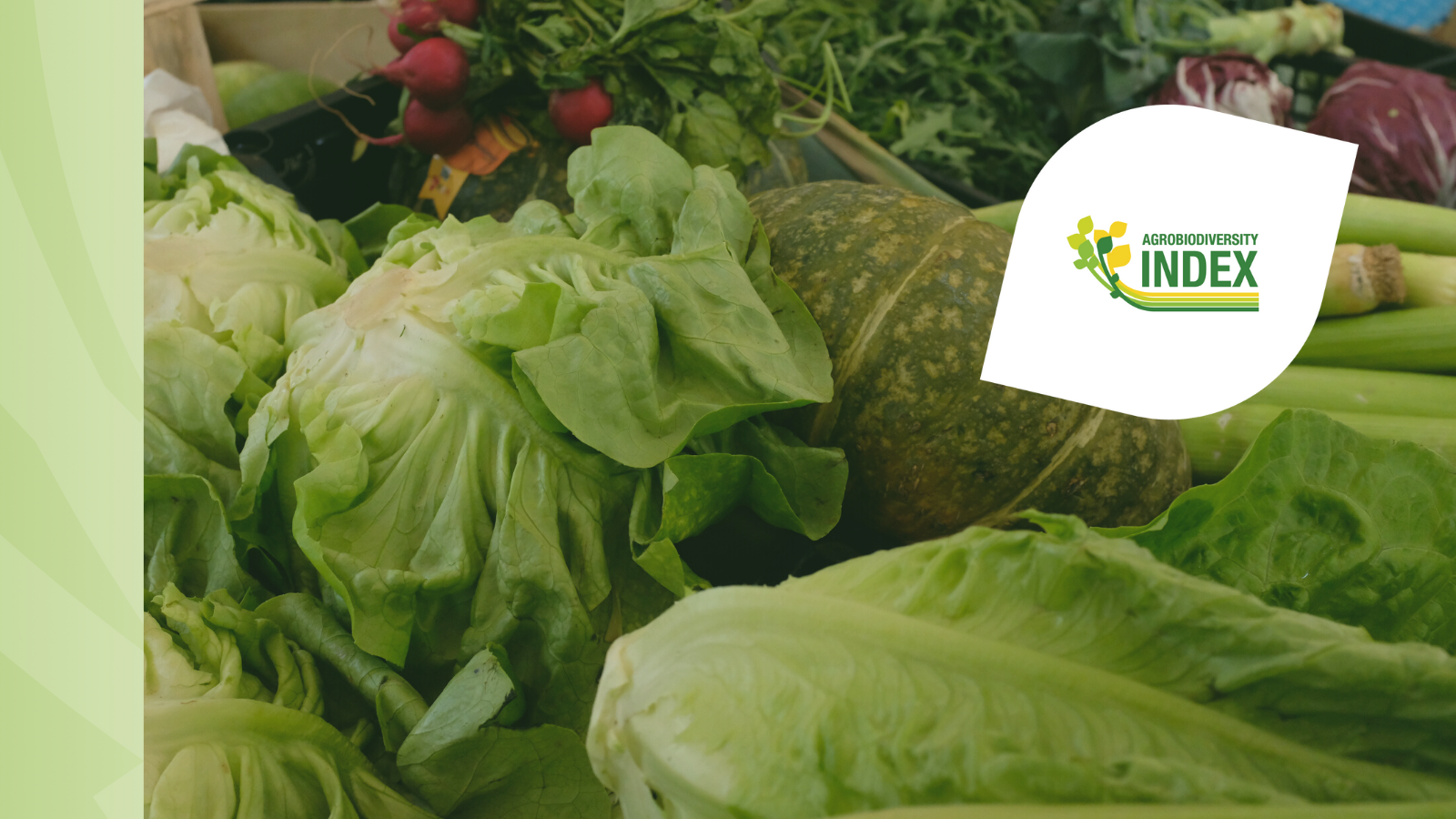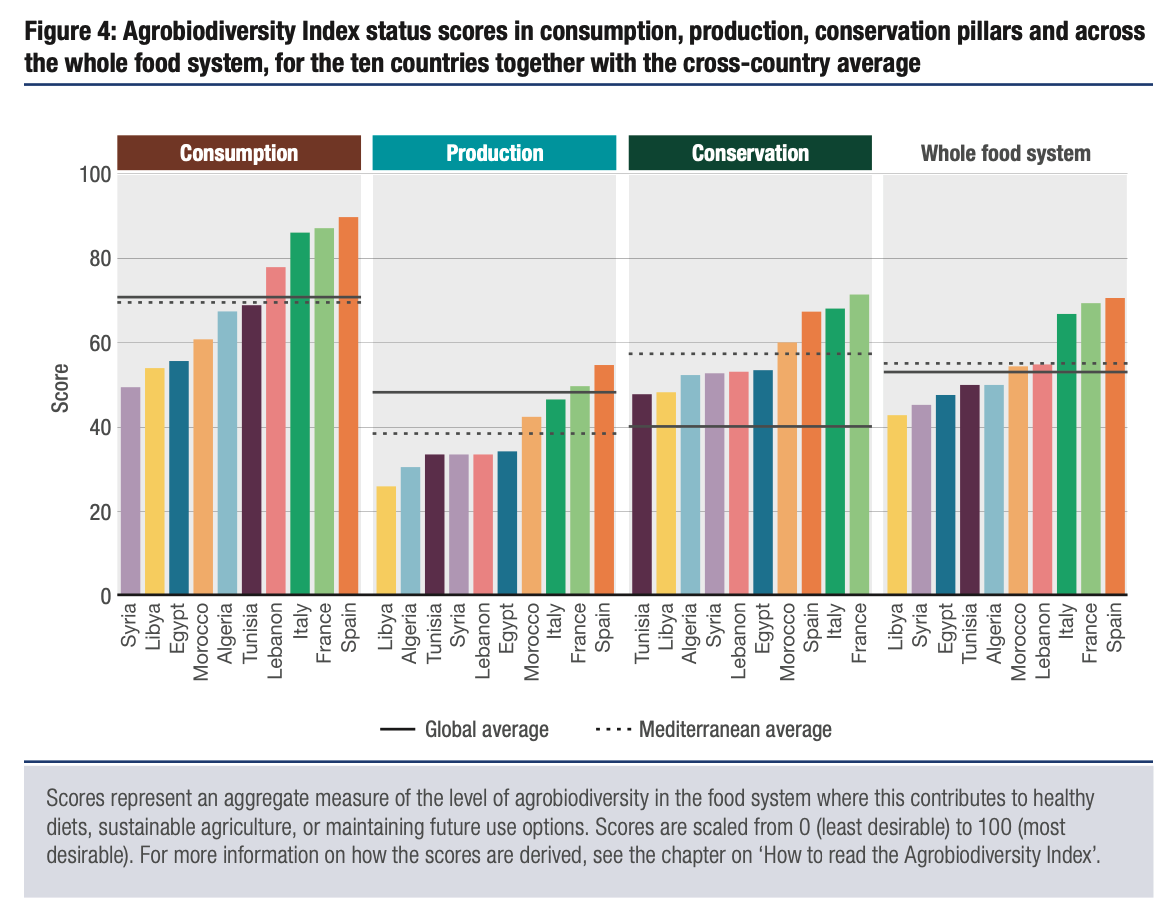Press and News Summary: Agrobiodiversity Index Report: Assessing Mediterranean Food Systems

The Alliance presents a new report assessing Mediterranean Agrobiodiversity. Key messages and takeaways follow:
Overview: What is the Report?
- The Agrobiodiversity Index provides a series of scores revealing the status of agrobiodiversity, and evidence of policy commitments and actions to conserve and make better use of agrobiodiversity, for achieving healthy diets, sustainable production, and conserving genetic resources.
- This report presents results of applying the Agrobiodiversity Index to 10 Mediterranean countries.
Main messages
- Agrobiodiversity includes the crops, livestock, insects, fungi and fish that we eat together with the pollinators, earthworms that keep soils healthy, insects that eat crop pests, and other plants and animals that support agricultural production and enable nutritious diets. These species play a central role in sustainable food systems.
- We monitor the status of agrobiodiversity using 15 indicators represented by globally comparable datasets.
- Results show that, overall, there is slightly more agrobiodiversity in Mediterranean food systems than the average across all countries in the world. This is particularly true for agrobiodiversity in conservation (such as in genebanks, botanical gardens, protected areas), indicating that Mediterranean agrobiodiversity (crop wild relatives and domesticated plants) is relatively well conserved.
- Most countries in the analysis have a high or very high level of agrobiodiversity in markets and diet availability, illustrating the high diversity of foods supplying Mediterranean diets.
- However, there is substantially less agrobiodiversity in Mediterranean production systems than the global average, indicating that Mediterranean production systems (in fields, farms and landscapes) lack diversity.
- Countries with the highest Agrobiodiversity Index scores showed more evidence of having taken actions to mainstream agrobiodiversity in food systems, such as through publishing healthy food-based diet guidelines, increasing the share of organic agricultural production, monitoring the use genetic resources for food as part of the World Information and Early Warning System.
- In all countries, there was a lack of attention and commitment to agrobiodiversity in national biodiversity strategies and action plans aimed at achieving the Convention on Biological Diversity (CBD) global biodiversity conservation targets.
- Large data gaps on some topics (such as food supplied in local markets and in dietary intake, distribution of crop varieties, and functional traits of conserved plants) inhibit effective agrobiodiversity monitoring.

An example figure from the report: Agrobiodiversity across the 10 countries.
Takeaways: Findings and Actions
- Stronger commitments and actions are needed to maintain and enhance the high diversity of the Mediterranean food production and food supply systems, which underpin the world-renowned Mediterranean diet.
- Agrobiodiversity in production is low in this sample of Mediterranean countries, which could put agricultural systems and livelihoods at increased risk from pest and disease outbreaks, soil degradation, and unstable yields. For example, most Mediterranean production landscapes are dominated by one or a handful of crops (low percentage of 10x10km agricultural landscapes with multiple crop species grown) and most of these landscapes have only a very small share of natural vegetation (<10%).
- Increasing farm and landscape complexity through planting a larger range of crop species and varieties within and across farms, and embedding natural habitat into farmland (hedgerows, flower strips, meadows, woodlots), will be important to maintain and restore natural processes (like biological pest control and pollination) and ensure resilient agricultural systems.
- In most Mediterranean countries, national commitments made to achieve CBD Aichi Targets do not include clear strategies to safeguard local, varietal, and functional diversity on-farm and within agricultural landscapes, or in genebanks, to safeguard the genetic resource pool that underpins our food system. There is also almost no mention of the need to safeguard diversity and ensure sustainable sourcing of food in (local) markets and diets which is critical to incentivize farmers to maintain agrobiodiversity on-farm. Almost no commitments considered the connection between the supply of essential (micro) nutrients in human diets, and the need to conserve of nutrient-rich crop varieties, soil biodiversity, and pollinators, which flags a lack of integration between biodiversity conservation and human nutrition goals. New action plans written to achieve the post-2020 Global Biodiversity Framework targets should address these gaps.
- Mediterranean countries with different Agrobiodiversity Index scores may prioritize different actions to shift to more sustainable food systems.
- For countries with relatively low Agrobiodiversity Index status scores across the food system (e.g. Algeria, Egypt, Syria, Libya, Tunisia), there is an urgent need to halt the loss of existing food system diversity by strengthening conservation initiatives for genetic resources for food and agriculture from farm to fork.
- For countries with relatively high Agrobiodiversity Index status scores overall but lower production scores (e.g. France, Italy, Lebanon, Morocco, Spain), focusing on diversifying fields, farms and production landscapes would be highly beneficial to create more sustainable food systems, including by promoting and incentivizing locally sourced, diverse and nutritious foods.
- Across all countries, renewed efforts are needed to monitor agrobiodiversity and light up black spots in knowledge. This includes better monitoring of diversified and ecological farming practices (intercropping, agroforestry, organic farming), and of the distribution of local and functionally diverse crops in fields, in local markets, and in genebanks.
